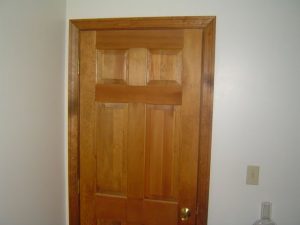There are many different Interior Door Styles to choose from when Shopping for an Interior Door
By Mark J. Donovan
|
|
Interior door styles range from the old rustic look to the modern contemporary look. There is no reason to limit your selection to the few stock interior door styles sold at your local home improvement center. If you speak with a store attendant or look on line, you can find a whole world of interior door styles to choose from. Summarized below are some of the more common interior door styles.
Rustic Interior Door Styles Rustic interior door styles are manufactured to highlight textures, wood grains and wood imperfections. |
They typically are not painted so that the wood grains and imperfections stand out and provide unique character to the door. Door manufacturers offer rustic interior door styles in 6, 4, and 2 panel v-groove door styles. Some styles also offer window lites. Door sizes range from 24” to 36” in width and standard 6’-8” in height.
Classic or Traditional Interior Door Styles
Classic or traditional interior door styles represent what is installed in most homes. Typically they are four or six panel doors that are made out of either solid wood or hollow particle board (Masonite). Some manufacturers offer window lites. Door sizes range from 24” to 36” in width and 6’-6” to 6’-8” in height.
Contemporary interior doors are usually smooth surfaced and use minimal trim and hardware. Window lites are kept to a minimum and they are typically square or rectangular in shape. Door sizes are available in similar sizes as classic or traditional interior door styles.
Colonial Interior Door Styles
Colonial interior door styles are typically made out of solid wood with raised molding, and are grand in both size and style.
They are usually constructed with 8 raised panels to represent the door styles that were used during American colonial times. Door sizes are available in similar sizes as classic or traditional interior door styles.
| Farmhouse Interior Door Styles
Farmhouse interior door styles represent the doors that were found commonly on American farms in the 1800s and 1900s. Farmhouse interior door styles are simplistic but functional. They typically feature square and rectangular panels. Some farmhouse interior door styles include arches or v-grooved patterns. Door sizes are available in similar sizes as classic or traditional interior door styles. Craftsman Interior Door Styles Craftsman interior door styles are all about showing hand craftsmanship and artistry. |
 |
They are commonly used in Mission, Shaker, Prairie, Art Nouveau and Arts and Crafts style homes. Craftsman interior door styles are known for their simple and traditional lines complemented with unique accents pieces such as v-grooved flat or raised panels and concealed hardware. Door sizes are available in similar sizes as classic or traditional interior door styles.
For information on how to install interior door trim, see the “Installing Interior Door Trim” eBook from HomeAdditionPlus.com. The “Installing Interior Door Trim” eBook provides step-by-step instructions on how to install interior door trim. Pictures are included for every key step in the process.
Related Information
- How to Refinish an Interior Door Video
- How to Determine Hand of Door When Buying an Interior Door
- How to Maintain a Door
Additional Door Resources from Amazon.com
 |
 |
Free Home Addition Price Quotes with No Obligation!
Fill out our 3-5 minute quick and easy form, and receive a free price quote on a house addition from one of our prescreened and licensed home addition contractors. This process is free and there is no obligation to continue once you receive your house addition price estimate.

